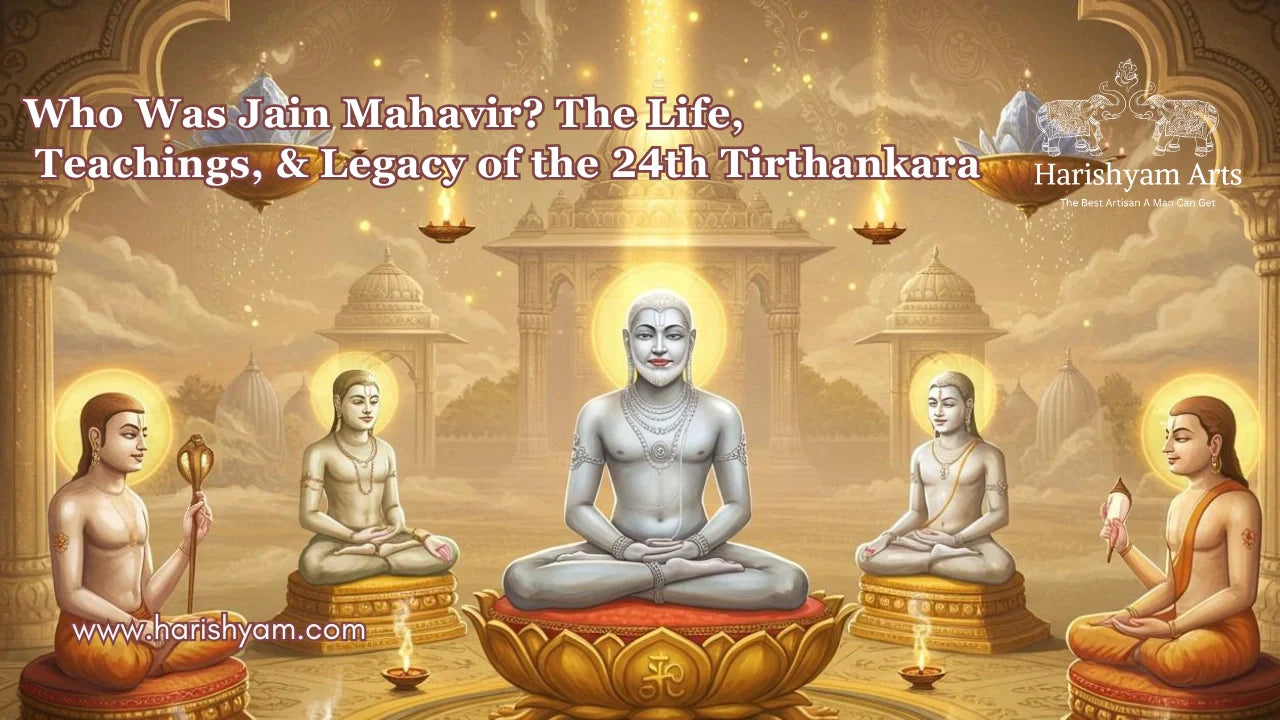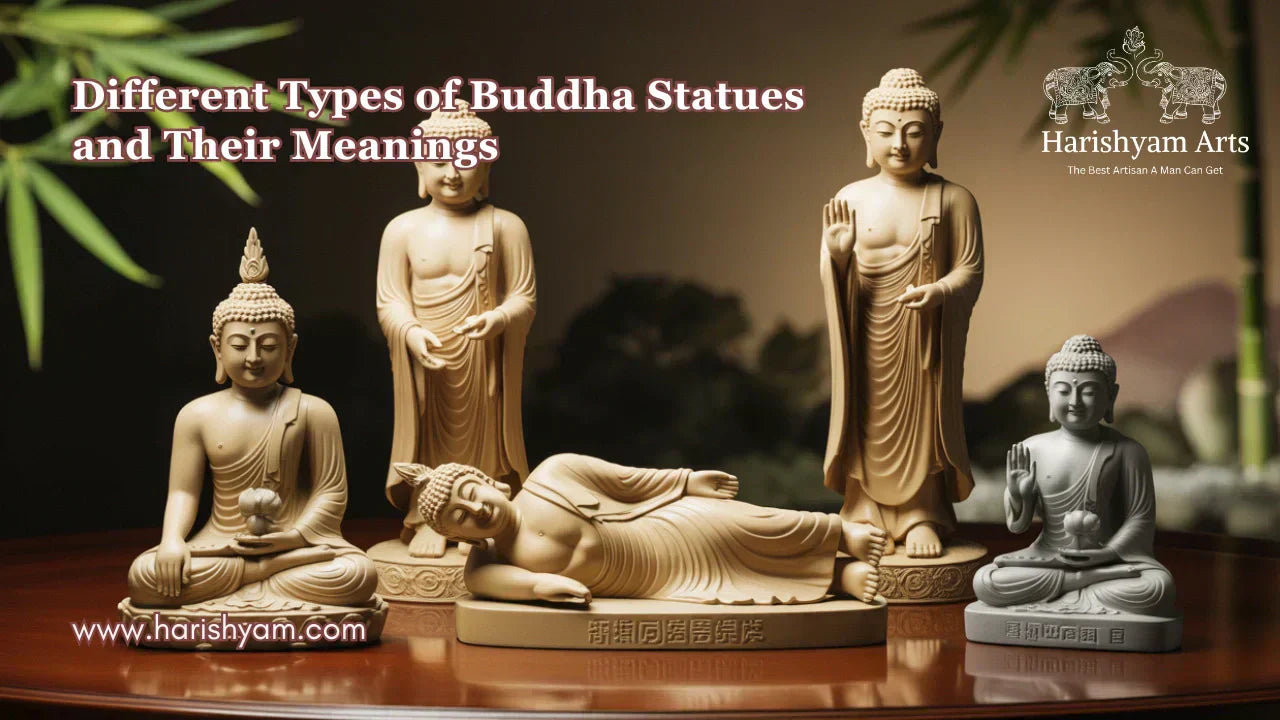Harishyam Arts Blog
The 24 Tirthankaras of Jainism: Names, Symbols, and Significance
By Lakshay Sharma | On 02 November, 2025 | Views

In Jainism, the Tirthankaras are revered as divine spiritual teachers who have conquered worldly desires and attained enlightenment. They guide others on the path of liberation, compassion, and truth. The word Tirthankara means “ford-maker,” symbolizing one who helps souls cross the ocean of worldly life and reach salvation. Jain philosophy recognizes 24 Tirthankaras in every time cycle, each representing supreme purity, wisdom, and self-discipline. At Harishyam Arts, we honor their legacy through beautifully crafted Jain idols and sculptures that inspire devotion and peace in every home and temple.
The Meaning of ‘Tirthankara’
A Tirthankara is not a creator or god in the conventional sense but a spiritually perfected soul who shows the path to others. The term comes from Sanskrit—Tirtha (crossing place) and Kara (maker). They create a “ford” for others to cross the cycle of birth and death. Each Tirthankara teaches the principles of Ahimsa (non-violence), Satya (truth), Asteya (non-stealing), Brahmacharya (chastity), and Aparigraha (non-possession). Their teachings emphasize self-realization, compassion for all living beings, and freedom from material attachment — timeless values that continue to guide humanity.
The 24 Tirthankaras: Names, Symbols, and Meaning



Spiritual Significance of the 24 Tirthankaras
Each Tirthankara serves as a spiritual beacon, guiding souls towards liberation through moral conduct and meditation. They remind humanity of the eternal values of compassion, non-violence, and truth. Their life stories demonstrate the power of self-restraint and purity, inspiring followers to rise above worldly attachments. Worshiping their idols cultivates inner peace and reminds devotees of their ultimate goal — Moksha (liberation).
The Complete 24 Tirthankaras
1. Rishabhanatha (Adinath)
Symbol: Bull | Birthplace: Ayodhya | Color: Golden | Time Period: Prehistoric (84,00,000 Purva)
Rishabhanatha, the first Tirthankara, is believed to have established the foundations of civilization by teaching agriculture, business, and other basics of life. Born to King Nabhi and Queen Marudevi, he governed with wisdom and kindness before renouncing his kingdom. After rigorous austerities, he attained Kevala Jnana and spent years teaching the path to moksha, finally achieving liberation at Mount Kailash. The bull symbol represents strength and steadfastness. Hindu scriptures including the Bhagavata Purana mention Rishabhnath, referring to him as Lord Vishnu, and the Vedas also reference his name.
2. Ajitanatha
Symbol: Elephant | Birthplace: Ayodhya | Color: Golden | Time Period: Prehistoric (72,00,000 Purva)
Ajitanatha, meaning "Invincible One," emphasized non-attachment and self-control in his teachings. Born to King Jitashatru and Queen Vijaya, he ruled prosperously before witnessing life's realities and choosing asceticism. He taught that spiritual growth comes through denial of material possessions and practiced harsh austerities before attaining omniscience.
3. Sambhavanatha
Symbol: Horse | Birthplace: Shravasti | Color: Golden | Time Period: Prehistoric (60,00,000 Purva)
Sambhavanatha, meaning "Auspicious," focused his teachings on non-violence and moral order. Born to King Jitari and Queen Susena, he displayed exceptional compassion toward all life forms from childhood. His reign was marked by justice and welfare, and he eventually renounced his kingdom to pursue spiritual truth through penance.
4. Abhinandananatha
Symbol: Monkey/Ape | Birthplace: Samet Sikhar | Color: Golden | Time Period: Prehistoric (50,00,000 Purva)
Abhinandananatha, meaning "Worship," advocated for non-attachment to material things and encouraged meditation as a path to enlightenment. Born to King Sinha and Queen Satyaki in Mithila, he was known for his modesty and gentleness. He served his kingdom simply before renouncing his throne to seek spiritual reality and attain Kevala Jnana.
5. Sumatinatha
Symbol: Goose/Heron | Birthplace: Ayodhya | Color: Golden | Time Period: Prehistoric (40,00,000 Purva)
Sumatinatha, meaning "Wise," taught understanding, clear vision, and right actions. Born to King Megha and Queen Mangala, he was nicknamed Sumati (wise intellect) due to his brightness from childhood. He governed with wisdom, ensuring his people lived affluent lives, before hearing the call of higher knowledge and becoming an ascetic.
6. Padmaprabha
Symbol: Red Lotus | Birthplace: Samet Sikhar | Color: Red | Time Period: Prehistoric (30,00,000 Purva)
Padmaprabha, meaning "Lotus-Bright," emphasized purity and spiritual detachment, along with mental and emotional health. Born to King Shridhar and Queen Susima, he was named after the lotus due to his beautiful fair complexion. As a responsible and sympathetic monarch, he came to understand material success's transient nature and renounced his throne to gain liberation through deep concentration.
7. Suparshvanatha
Symbol: Swastika | Birthplace: Samet Sikhar | Color: Golden | Time Period: Prehistoric (20,00,000 Purva)
Suparshvanatha, meaning "Good-sided," preached non-violence and embraced moderate living while protecting mental self-discipline. Born to King Pratistha and Queen Prithvi, he possessed wisdom and compassion from birth. He was a kind, fair, and wise king who relinquished his throne for spiritual life and attained liberation after years of meditation and austerity.
8. Chandraprabha
Symbol: Crescent Moon | Birthplace: Chandrapuri | Color: White | Time Period: Prehistoric (10,00,000 Purva)
Chandraprabha, meaning "Moon-bright," focused on calmness and tranquility of mind. Born to King Mahasena and Queen Lakshmana, he was known for his quiet, calm, and collected nature. He exercised power fairly and benignly before becoming dissatisfied with ephemeral worldly rewards and taking up the life of a hermit, gaining Kevala Jnana through intense meditation.
9. Suvidhinatha (Pushpadanta)
Symbol: Crocodile/Dolphin | Birthplace: Kakandi | Color: White | Time Period: Prehistoric (2,00,000 Purva)
Suvidhinatha, also known as Pushpadanta meaning "Blossomed-toothed," showed that charity, righteousness, and selflessness lead to liberation. Born to King Sugriva and Queen Rama, he was blessed with a fantastic intellect and superb skills. After ruling fairly for many years, his desire for worldly things diminished, and through strict self-rule, he became omniscient.
10. Shitalanatha
Symbol: Wishing Tree (Kalpavriksha)/Shrivatsa | Birthplace: Bhadrikpuri | Color: Golden | Time Period: Prehistoric (1,00,000 Purva)
Shitalanatha, meaning "Coolness," taught non-activity, non-attachment to the body, and calmness. Born to King Dridharatha and Queen Nanda, he was a great, fair, and kind ruler. Like all Tirthankaras, he recognized the world's impermanence and gave up his throne, seeking salvation through austerity and yoga, ultimately attaining Kevala Jnana.
11. Shreyansanatha
Symbol: Rhinoceros | Birthplace: Samet Sikhar | Color: Golden | Time Period: Prehistoric (84,00,000 Years)
Shreyansanatha, meaning "Good," promoted right conduct, restraint, and proper behavior toward spiritual progress. Born to King Vishnu and Queen Vishnu Devi in Simhapuri, he was endowed with a good heart and characterized by wise kingship. He abdicated and became a hermit, becoming so proficient in penance that he eventually rose to omniscience.
12. Vasupujya
Symbol: Buffalo | Birthplace: Champapuri | Color: Red | Time Period: Prehistoric (72,00,000 Years)
Vasupujya, meaning "Worship with offerings," preached asceticism and temperance, emphasizing patience, tolerance, simple living, steadiness, and removal of desire. Born to King Vasupujya and Queen Jaya in Champapuri, he was a hero and benevolent king who protected his people. Despite his successful monarchy, he left his kingdom in search of spiritual realization and attained Kevala Jnana through years of penance.
13. Vimalanatha
Symbol: Boar | Birthplace: Kampilya | Color: Golden | Time Period: Prehistoric (60,00,000 Years)
Vimalanatha, meaning "Clear," recognized the need for purity of mind, body, and spirit. Born to King Kratavarma and Queen Shyamadevi in Kampilya, he was always fair with a clear conscience. Understanding that worldly wealth has no eternity, he abdicated his throne and became an ascetic, achieving omniscience after years of penance.
14. Anantanatha
Symbol: Falcon/Hawk/Bear | Birthplace: Ayodhya | Color: Golden | Time Period: Prehistoric (30,00,000 Years)
Anantanatha, meaning "Endless," emphasized non-possession and dedication to supreme spiritual goals. Born to King Sinhasena and Queen Suyasha in Ayodhya, he was remembered for his wisdom. Understanding everything's temporary nature, he left the throne and practiced for his soul's spiritual liberation, arriving at Kevala Jnana status through meditation.
15. Dharmanatha
Symbol: Vajra (Thunderbolt) | Birthplace: Ratnapuri | Color: Golden | Time Period: Prehistoric (10,00,000 Years)
Dharmanatha, meaning "Duty," gave direction on righteousness, truth, and ethical duty. Born to King Bhanu and Queen Suvrata in Kausambi, he was a righteous and just king admired for justice and favor. Understanding royal power and fame's ephemeral nature, he left his palace and kingdom for extreme austerity, dedicating himself to meditation and spiritualism until achieving supreme omniscience.
16. Shantinatha
Symbol: Deer/Antelope | Birthplace: Hastinapur | Color: Golden | Time Period: Prehistoric (1,00,000 Years)
Shantinatha, meaning "Peace," was the embodiment of non-violence, peace, and inner stillness. Born to King Vishvasena and Queen Achira in Shikharagiri, he was famous for his calmness and understanding. He governed with emphasis on non-violent conflict resolution before realizing life's vanity and leaving his kingdom to become a hermit monk, achieving Kevala Jnana through rigorous meditation and self-control.
17. Kunthunatha
Symbol: Goat | Birthplace: Hastinapur | Color: Golden | Time Period: Prehistoric (95,000 Years)
Kunthunatha, meaning "Heap of Jewels," taught righteousness and kindness to all beings. Born to King Shursena and Queen Shridevi in Champa, he was admired for intelligence and moral principles. After reigning justly, he embraced ascetic life, abdicated his kingship to search for truth, and performed severe austerity to obtain Kevala Jnana.
18. Aranatha
Symbol: Fish/Nandyavarta | Birthplace: Hastinapur | Color: Golden | Time Period: Prehistoric (84,000 Years)
Aranatha, meaning "Division of time," preached non-attachment and spiritual practice. Born to King Sudarshana and Queen Devi at Ahalyapur, he was a king of justice and mercy. Recognizing the world's falsity after glamour passed, he gave up his kingdom and became a hermit, gaining deep spiritual understanding through meditation.
19. Mallinatha
Symbol: Water Pot (Kalasha) | Birthplace: Mithila | Color: Blue | Time Period: Prehistoric (55,000 Years)
Mallinatha, meaning "Wrestler," emphasized humility and spiritual equality. Mallinatha is unique as the only female Tirthankara among the 24, though this is debated—some Digambara sect Jains believe she was reborn as a man before becoming a Tirthankara. Daughter of King Kumbha and Queen Prabhavati, born in Vallabhipur, she was beautiful and intelligent. She advocated for women's spiritual rights and successfully practiced austerities that brought her to Kevala Jnana.
20. Munisuvratanatha
Symbol: Tortoise | Birthplace: Kusagranagar | Color: Black | Time Period: Prehistoric (30,000 Years)
Munisuvratanatha, meaning "Of good vows," concentrated on tolerance and self-control. Born to King Sumitra and Queen Padmavati in Pundarik, he was introspective and astute. After achieving much in his political career as a wise, just, and compassionate monarch, he abdicated to become a seeking Yogi and attained perfect knowledge through strict meditation practice.
21. Naminatha
Symbol: Blue Lotus | Birthplace: Mithila | Color: Golden | Time Period: Prehistoric (10,000 Years)
Naminatha, meaning "Bowing Down," called for union of individual soul with universal soul, emphasizing non-violence and enlightenment. Born to King Vijay Chakravathi and Queen Vapra Devi in Rajagriha, he was kind and wise. He successfully governed with kindness before giving up power and kingdom upon understanding material world's temporary nature, receiving Kevala Jnana through deep concentration.
22. Neminatha (Arishtanemi)
Symbol: Conch Shell | Birthplace: Dvaraka | Color: Black | Time Period: Contemporary of Lord Krishna (1,000 Years)
Neminatha, meaning "The rim of whose wheel is unhurt," instituted non-attachment to material possessions and compassion. Born to King Samudravijaya and Queen Shivadevi in Dwarka, he is stated to be Lord Krishna's cousin. He was a man of justice and charity who stressed welfare throughout his kingdom. In paintings, he is depicted with dark complexion. Realizing materialistic glory's impermanence, he exited the world in search of spiritual emancipation, gaining full realization to become a Kevala Jnani through austerities and spiritual practices.
23. Parshvanatha
Symbol: Snake/Serpent | Birthplace: Kashi (Banaras) | Color: Blue/Green | Time Period: 877-777 BCE (100 Years)
Parshvanatha, meaning "Lord Serpent," is believed to have existed two centuries before Mahavira. Born around 817 BCE to King Ashvasena and Queen Vamadevi in Varanasi, he was a righteous king whose kingdom was dominated by non-violence and truth. He is said to have propounded Jain religion, which was later revived by Mahavira. According to Svetambaras Sect, Parshvanath founded the four-fold restraints: Ahimsa (non-violence), Satya (truthfulness), Asteya (non-stealing), and Aparigraha (non-possession)—the fifth vow, Brahmacharya (celibacy), was added by Mahavira. Understanding the illusory nature of worldly beauty, he abdicated and indulged in austerities, attaining Kaivalya on Mount Sammeta (Parasnath) in Jharkhand. The Navagraha Jain Temple in Karnataka houses the tallest statue of Parsvanath.
24. Mahavira (Vardhamana)
Symbol: Lion | Birthplace: Kshatriyakund (Bihar) | Color: Golden | Time Period: 599-527 BCE (72 Years)
Mahavira, meaning "Prospering great hero," is the most important among the Tirthankaras and shaped modern Jainism. Originally known as Vardhamana, he was born around 599 BCE to King Siddhartha and Queen Trishala in Vaishali kingdom. He was a contemporary of Gautam Buddha. From childhood, Mahavira had profound religious perception and great sensitivity. At age 30, after his parents' death, he gave up his royal lifestyle to seek a spiritual path. He followed rigorous penance and meditation for twelve years and attained Kevala Jnana under a Sal tree. He brought back the basic principles of Jainism: Ahimsa (non-violence), Satya (truthfulness), Brahmacharya (celibacy), and Aparigraha (non-possession). After enlightenment, Mahavira was totally involved in preaching Jainism's tenets and establishing a major Jain order of monks and nuns. He attained Nirvana in Pavapuri, Bihar.
Depiction in Jain Art and Sculpture
In Jain temples and homes, Tirthankaras are depicted in meditative postures — either seated in Padmasana or standing in Kayotsarga. Each idol is marked with a unique symbol below it for identification. At Harishyam Arts, our artisans craft marble Jain idols that reflect divine serenity and traditional design. You can also explore our “Customize my Idol“option to create personalized Jain Tirthankara idols for your mandir or gifting.
Frequently Asked Questions (FAQs)
Q1. Who are the Tirthankaras in Jainism?
Ans: Tirthankaras are enlightened souls who have conquered worldly desires and help others achieve liberation. There are 24 Tirthankaras in each time cycle of Jain cosmology.
Q2. Why are there 24 Tirthankaras?
Ans: According to Jain belief, every half-cycle of time has 24 Tirthankaras who appear to guide souls toward liberation when spiritual decline occurs in society.
Q3. Who is the first and last Tirthankara?
Ans: The first Tirthankara is Rishabhdev (Adinath), who established spiritual and social order. The last, Mahavira, lived in the 6th century BCE and revived Jain teachings for the modern age.
Q4. What is the significance of the symbols of Tirthankaras?
Ans: Each Tirthankara has a distinct symbol that represents their spiritual essence and virtue — such as the lion for Mahavira symbolizing courage and the snake for Parshvanath representing protection.
Q5. How are Tirthankaras depicted in art?
Ans: In Jain art, Tirthankaras are portrayed in serene meditation postures, with calm expressions and symbolic emblems. Artisans at Harishyam Arts create these idols in brass, wood, and marble, capturing divine grace and purity.
Conclusion – The Eternal Message of Jainism
The teachings of the 24 Tirthankaras illuminate the path of spiritual awakening. Their lives embody peace, simplicity, and compassion, guiding us toward harmony with all beings. In today’s fast-paced world, their message of inner balance and non-violence is more relevant than ever. Explore exquisite Jain idols and handcrafted art at Harishyam Arts — where devotion meets artistry, and faith finds its true form.
In Jainism, the Tirthankaras are revered as divine spiritual teachers who have conquered worldly desires and attained enlightenment. They guide others on the path of liberation, compassion, and truth. The word Tirthankara means “ford-maker,” symbolizing one who helps souls cross the ocean of worldly life and reach salvation. Jain...

Lakshay Sharma
I’m Lakshay Sharma, a writer with a deep passion for Hindu mythology, Vastu Shastra, and home interiors. I enjoy exploring the rich traditions of Hindu gods and goddesses, sharing insights into Vastu principles, and offering guidance on creating sacred spaces like Puja Mandirs. Through my writing, I aim to inspire harmony and spiritual well-being, blending traditional knowledge with modern perspectives.
Harishyam Arts | Jaipur
Related Blogs

Who is Parashvanath? The Life and Legacy of Jainism’s 23rd Tirthankara
Lakshay Sharma | November 22, 2025
Faith and spirituality are cornerstones of Indian tradition, and Jainism stand...
Read More...
How to Choose Between Carved and Minimalistic Wooden Mandirs
Lakshay Sharma | November 21, 2025
A home mandir (temple) is far more than just a piece of furniture; it is the s...
Read More...
How to clean silver god idols at home
Lakshay Sharma | November 21, 2025
At Harishyam Arts, we understand the spiritual and aesthetic significance of s...
Read More...
Are Marble Dust Statues Ideal for Your Home Temple? Pros & Cons
Lakshay Sharma | November 19, 2025
When it comes to selecting statues for your home temple, marble dust statues h...
Read More...
Where to Buy Authentic Marble Gods' Moortis in the USA: A Guide for Devotees and Collectors
Lakshay Sharma | November 19, 2025
For devotees and collectors in the USA seeking authentic marble Hindu god moor...
Read More...
Maa Parvati 108 Names in Sanskrit and English: Their Significance, Meaning, and Mantra Power
Lakshay Sharma | November 17, 2025
The Divine Essence of Maa Parvati
Maa Parvati,...
Read More...
8 Guidelines for Setting Up Your Home Mandir with Wooden Murtis: Location, Selection, and Maintenance.
Lakshay Sharma | November 16, 2025
Introduction: The Divine Mother of Strength and Compassion

Who Was Jain Mahavir? The Life, Teachings, and Legacy of the 24th Tirthankara
Lakshay Sharma | November 15, 2025
Lord Mahavir, the 24th Tirthankara of Jainism, was a spiritual reformer who re...
Read More...
Benefits of Choosing Corian Mandirs Over Marble and Wood
Lakshay Sharma | November 14, 2025
Modern homes today demand elegance, functionality, and easy upkeep — and Coria...
Read More...
White vs. Black Shivling: Which One Is Best for Your Home and Why?
Lakshay Sharma | November 13, 2025
The Shivling, a sacred symbol of Lord Shiva, embodies creation, power, and pur...
Read More...
10 Stunning Marble Handicraft Pieces to Elevate Your Home Décor
Lakshay Sharma | November 12, 2025
Marble handicrafts represent timeless artistry, luxury, and devotion. At Haris...
Read More...
Brass Ganesha Idols as Gifts: Symbolism, Occasions, and Gifting Etiquette
Lakshay Sharma | November 11, 2025
Gifting a brass Ganesha idol is more than a gesture—it's a blessing of prosper...
Read More...
Luxury Kids Room Decor Ideas That Turn Every Space Into a Fairytale Dream
Lakshay Sharma | November 10, 2025
Transforming a child’s room into a luxury fairytale dream combines comfort wit...
Read More...
Why Repainting Your Marble Statue Can Extend Its Life and Beauty
Lakshay Sharma | November 09, 2025
Marble statues are elegant pieces of art that add charm to any home or temple....
Read More...
How to Choose the Perfect Wall-Mounted Wooden Mandir for Your Home
Lakshay Sharma | November 08, 2025
A wall-mounted wooden mandir is more than just a spiritual corner; it’s a blen...
Read More...
Understanding GST on Marble God Statues: A Complete Guide for Buyers and Sellers
Lakshay Sharma | November 07, 2025
Marble god statues are a popular choice for temples, homes, and offices due to...
Read More...
Are Wooden Statues Pest-Resistant? How to Protect Your Wooden Idols from Insects and Damage
Lakshay Sharma | November 06, 2025
Wooden statues have been cherished for centuries due to their natural beauty a...
Read More...
Corian vs Wooden Temples: Which One Should You Choose?
Lakshay Sharma | November 05, 2025
Choosing the perfect temple for your home is more than just selecting a design...
Read More...
How Customised Marble Human Bust Manufacturers Bring Personalities to Life
Lakshay Sharma | November 04, 2025
Crafting a marble human bust is so much more than sculpting a likeness—it's ab...
Read More...
The Power of the Hare Krishna Maha Mantra: Awakening Spiritual Bliss
Lakshay Sharma | November 03, 2025
The Hare Krishna Maha Mantra is a sacred chant that ...
Read More...
The 24 Tirthankaras of Jainism: Names, Symbols, and Significance
Lakshay Sharma | November 02, 2025
In Jainism, the Tirthankaras are revered as divine s...
Read More...
Top 25 Space-Saving Wooden Mandir Ideas for Modern Homes
Lakshay Sharma | November 01, 2025
A pooja mandir is the heart of every Indian home — a sacred corner where peace...
Read More...
What Are the 8 Forms of Lakshmi? | Ashta Lakshmi Meaning and Significance
Lakshay Sharma | October 31, 2025
The Divine Essence of Goddess Lakshmi
Goddess La...
Read More...
The Art of Craftsmanship: How Handmade Brass Statues Are Created
Lakshay Sharma | October 30, 2025
At Harishyam Arts, we celebrate the timeless beauty ...
Read More...
How to Dispose of Broken Marble God Murti
Lakshay Sharma | October 30, 2025
In Hindu tradition, marble murtis represent divine presence and spiritual ener...
Read More...
Wooden Statues vs Marble Statues: Which One Should You Choose?
Lakshay Sharma | October 29, 2025
When it comes to decorating your home or creating a sacred space, choosing the...
Read More...
How a Wooden Temple Enhances Positive Energy in Your Home
Lakshay Sharma | October 28, 2025
A home temple isn’t just a decorative corner — it’s the spiritual...
Read More...
Why Lord Krishna is Worshipped in Different Forms Across India
Lakshay Sharma | October 27, 2025
Lord Krishna — the eighth incarnation of Lord Vishnu — is one of the most belo...
Read More...
The Story of Goddess Saraswati: The Embodiment of Wisdom and Knowledge
Lakshay Sharma | October 26, 2025
Among the many deities of the Hindu pantheon, Maa Saraswati Read More...

Top Reasons to Choose Brass Statues for Home Décor and Spiritual Spaces
Lakshay Sharma | October 25, 2025
Home décor today is not only about beauty—it’s about creating a peaceful and m...
Read More...
How long do Corian temples last?
Lakshay Sharma | October 24, 2025
Choosing the right material for a temple at home is important for both aesthet...
Read More...
Why Lord Shiva is Called the Mahadeva – The Supreme God
Lakshay Sharma | October 23, 2025
Hinduism, one of the world’s oldest religions, has a rich pantheon of deities,...
Read More...
Why Corian Temples Are Becoming Popular in Contemporary Homes
Lakshay Sharma | October 22, 2025
In today’s modern homes, interior décor blends tradition with contemporary sty...
Read More...
Dome or No Dome? Choosing the Right Design for Your Home Temple
Lakshay Sharma | October 21, 2025
Creating a sacred space at home is a spiritual investment, and the design of y...
Read More...
Traditional vs Modern Wooden Temples: Which Suits Your Space?
Lakshay Sharma | October 20, 2025
Creating a sacred space in your home is more than just interior décor — it’s a...
Read More...
Top Marble Types for Pooja Mandirs: A Complete Buyer’s Guide
Lakshay Sharma | October 19, 2025
A Pooja Mandir is more than just furniture; it is th...
Read More...
The Different Forms of Shiva Statues and their Symbolism
Lakshay Sharma | October 18, 2025
Introduction to the God Shiva Statue
Lord Shiv...
Read More...
Guide to Choosing the Perfect Wooden Statue for Home and Office Décor
Lakshay Sharma | October 17, 2025
Wooden statues are more than decorative pieces—they are timeless symbols of ar...
Read More...
Understanding the Difference Between Handmade and Machine-Made Brass Statues
Lakshay Sharma | October 16, 2025
Brass statues have been a cornerstone of spiritual and decorative art for cent...
Read More...
Where to Buy Custom Marble Statue Online? A Complete Guide
Lakshay Sharma | October 15, 2025
Marble statues have always held a special place in Indian homes and temples. T...
Read More...
Mistakes You Shouldn’t Make When Purchasing a Home Temple Online
Lakshay Sharma | October 14, 2025
Buying a home temple online can be an exciting experience — especially with so...
Read More...
Mistakes You Shouldn’t Make When Purchasing a Home Temple Online
Lakshay Sharma | October 14, 2025
Buying a home temple online can be an exciting experience — especially with so...
Read More...
How to Clean and Maintain Wooden Statues at Home
Lakshay Sharma | October 13, 2025
Wooden statues add elegance, tradition, and warmth to any home. From intricate...
Read More...
Can We Keep the Lakshmi Statue at Home?
Lakshay Sharma | October 13, 2025
In Hindu tradition, Goddess Lakshmi is worshipped as the divine force of wealt...
Read More...
How to Clean Brass Statues at Home?
Lakshay Sharma | October 12, 2025
Brass statues add a touch of elegance and spirituality to any home. At Harishy...
Read More...
Which Lakshmi Idol is Good for Home? Types, Materials, and Significance
Lakshay Sharma | October 11, 2025
Goddess Lakshmi, the divine symbol of wealth, prosperity, and abu...
Read More...
Is Corian Good for Mandir? A Complete Guide
Lakshay Sharma | October 10, 2025
When it comes to designing a home mandir, choosing t...
Read More...
Different Types of Buddha Statues and Their Meanings
Lakshay Sharma | October 09, 2025
Buddha statues are more than just beautiful decorative pieces—they symbolize s...
Read More...
How to Identify a Real Habur Stone? A Complete Guide
Lakshay Sharma | October 08, 2025
Habur stone, known for its mysterious ability to turn milk into curd naturally...
Read More...
How long does Marble Statues Last?
Lakshay Sharma | October 06, 2025
Marble statues can last for centuries, or even thousands of years...
Read More...



